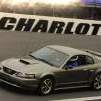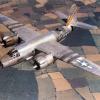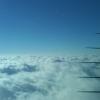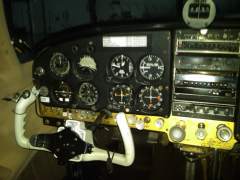Leaderboard
Popular Content
Showing content with the highest reputation on 08/29/2013 in all areas
-
2 points
-
I finally got a Mooney. I've wanted one for years. My 1975 M20F seems to be everything I thought it would be. I'm ready to accumulate some hours . I've kept up with this site for a while now and expect to put some of the good information to use. As a new Mooney owner I'm sure I will have many questions for all you experienced owners. Hello to all!1 point
-
I've taken a guy up from Asheville, NC and he ended up buying a "C". I'm located at 8A6 just East of Charlotte, NC. We have 3 flying Mooneys located here, and one not flying. Ready to treat someone else to the life of the FAST and FURIOUS ! BILL1 point
-
Try out the simulator. I liked the additional functionality of the 750 and went for it.1 point
-
Finally properly home. It's amazing what you can do in a 1966 M20E, which I bought for about $20,000 just last year. With a bit of TLC, and a smattering of new toys, it has become a fabulous travelling machine. Thanks to everyone on this thread for your support and encouragement!1 point
-
I can land a lot shorter with the speed brakes. Turn final about 1/2 mile out 300 feet high power off and speed brakes out. Pitch to maintain speed. I have to plan my turn to final properly, you get a feel for it. I flare over the dirt and touch down on the numbers. My rollout is usually about 300 feet.1 point
-
I don't work for Jack Rousch don't know him and can't stand NASCAR! But, with that being said he has done great things for warbirds in particular and aviation in general. He has a never crashed a warbird. His AL lake crash was in a Aircam which (you'll agree) is quite a ways off from a P-51D. http://www.aircam.com/ . His other crash was the Premier Jet at Oshkosh.1 point
-
Speed improvements are mostly significant on long flights On a 200nm a 5kts difference translate to a 2 minutes difference. However on 1000nm a 5kts difference translate to 12 minutes difference. But if you need to stop for fuel the difference can be more than an hour. I found that adding extra fuel allows me to run at higher power thus higher speed non-stop thus shorter time, vs stoping for refueling or running at low speed to increase range. If you encounter headwinds and have to land for refuel your speed mod investment goes down the drain. For a speed mod to be significant the plane has to be run at high power setting, thus more fuel. At low power setting (less drag) speed mods are insignificant. I measure speed in total trip time vs true air speed. Time for ground preparation for a flight should be part of the total trip time. By coincidence my front hangar neighbor was headed to KORL on his Citation I jet at the same time I has headed there too. By the time I started taxing out he and his copilot were still doing checks on the plane in the hangar. I arrived at KORL and pickup the crew car to drop my wife at my son home. By the time I was leaving the gate I saw my friend taxing in his jet. When I drove back to the airport he was still loading the rental car. The same can be said when comparing an airline flight vs your Mooney. I even include the driving and parking in the total trip time. To me is the total trip time what matters. José1 point
-
Gentlemen, I haven't posted lately as the A* has been in the avionics shop for a "new" panel. I finally decided on Aspen Evolution 2000, two new GTN-650's, EDM 760 engine monitor and a new PMA 8000 audio panel. Kept the weather radar and Stormscope, of course.. Oh, and did I say a new panel. Supposed to pick it up Friday. I had it scheduled for the paint shop for next week but got bumped by a Falcon 50 that the shop was charging $65,000 to paint, seems cheap to me? My sons are home after finishing grad school and getting ready to go out on the world. One has never gotten his PPL so we've been working in the Skylane to get him ready for his check ride; next Tuesday probably. That will make me the recommending instructor for both my boys; great feeling. Now, if I can just live long enough for the grandson to do the same; not likely though. For those of you who are interested, I am going to write up a short "flying brief" of takeoff, climb, cruise, descent, and landing for the A*. I'll be able to post my first impressions of the Aspen and 650's as well. I suspect that I'll have some learning curve there. FYI. I'm almost embarrassed to say this, but my training in the A* got really side tracked. I go to shoot 8 landings with the broker who handled the transaction and that was about it. I memorized the POH, familiarized myself with the systems and frankly spent the next 15 hours teaching myself how to fly it. The A* has one real "gotcha" that I will reveal at a later date. Finally I got to fly with an approved A* instructor for 1.5 hours and by then, he confessed that as foolish as it was, I had been a pretty good teacher. The insurance company covered me but said they wanted me to have a IPC before September 1. Yes that means my first 15 hours was without coverage. Last week, I went to Recurrent Training Center in Champagne, Illinois and got A* recurrent, IPC, Bi-annual, and high altitude certification. I spent an entire afternoon in a simulator doing engine outs just after wheels up that I think was very valuable. We literally did them until I developed some "muscle memory" from the repetition, always SHOUTING, "left foot dead feather left engine" and vice versa. I recommend RTC for those of you who want to brush up your instrument skills. They have good sims and will fly with you in your airplane as well. Champagne, Ill, is one nice town as well. Not a bad place to spend three days. By the way, the price for the 3 days was only $1700. Understand, I do not recommend this self instruction business and don't intend to do it again. More on the A* later. With pics hopefully. Jgreen1 point
-
Do they change the VLo speeds at all? I would love to get my gear speeds up closer to a J's.1 point
-
1 point
-
Hopefully someone fired your plane up for 30sec-1 min to keep oil on all the parts during the down time or better yet flew it in the mean time. Off topic but as a reminder, and the OP may have but if its gonna sit make sure it sits with clean oil in the case.....sorry ADHD kicking in.....1 point
-
It's all horses for courses - of course not having it means that it won't fail, but then not having it means you might not be able to despatch in the first place. I went turbo, as when I was looking to move up, I had FIKI down as a 'must have'. The general feeling from those in a similar place to me was that a turbo was worth more than FIKI, but having both was the best. Over here in Europe, we also have that division between the lower routes (below FL195) and the upper (above FL195), and Eurocontrol won't accept a non-turbo aircraft into the UIR, this blocking the availability for a number of routes. My regular routes go through OK in the lower airspace, but the odd trip can cut off significant chunks by going up a couple of thousand feet (eg you can't overfly Paris below FL200) - even in an O3 that would mean going round the outside if you're going east, and there is only one FL available if going west (but you won't be able to file it!) It was a previous owner of mine that got through three turbos, one of which was marked down to 'ice damage' A quick look didn't reveal it, but I seem to remember that there was a mod to the airbox assembly which increased the size of the holes at the back to alleviate this, so I would be surprised if this had been a one off incident. So far for me, there have been a multitude of things that have caused a fail to despatch/divert/modify the plan, but as yet, none have been turbo related. Of course, YMMV, depending on the individual aircraft and your attitude to maintenance. Biggest worry will be the big Lycoming's inability to run on anything less than 100grade AvGas - until the future for AvGas is a bit more certain, I think this is the most significant hurdle to long-term ownership Like most things, you pays yer money and makes yer choice!1 point











